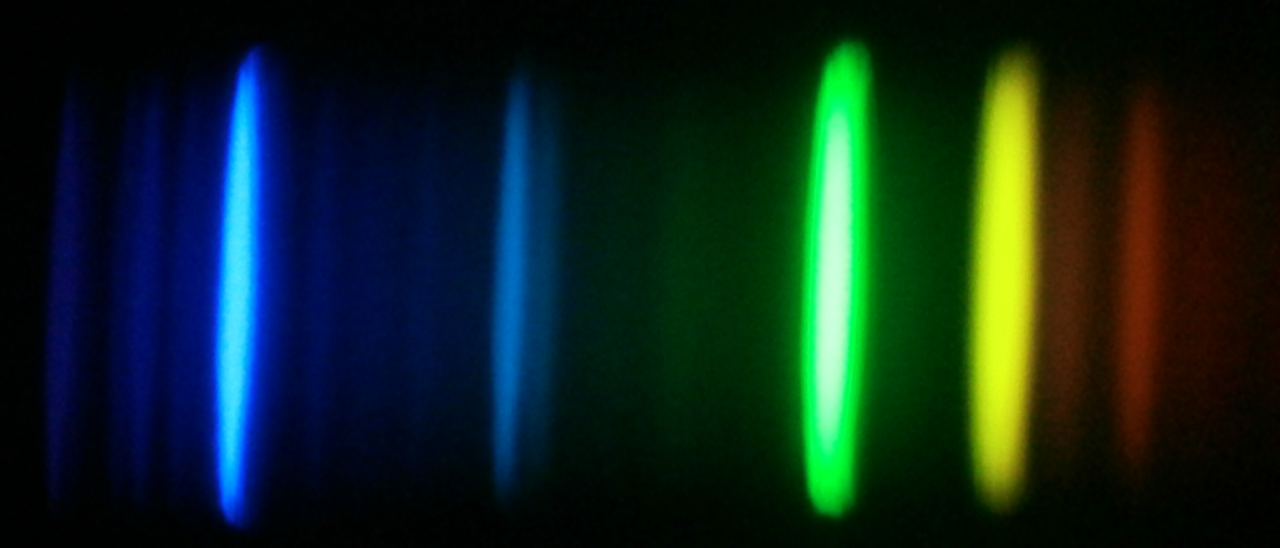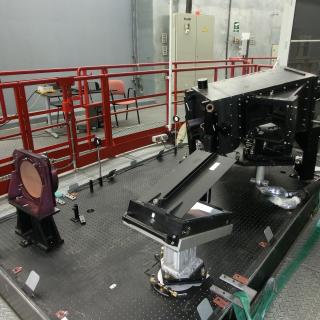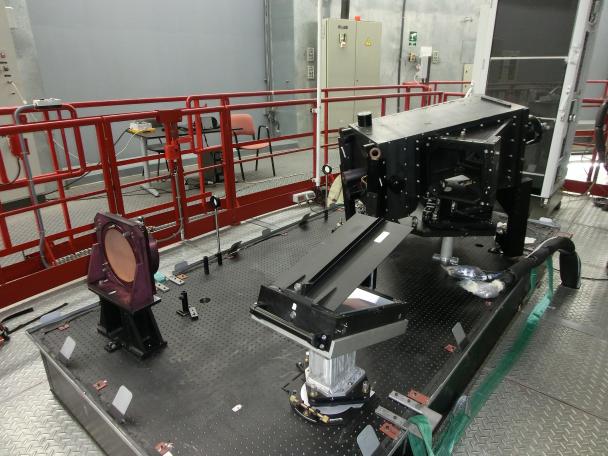Grants related:
General
Stellar spectroscopy allows us to determine the properties and chemical compositions of stars. From this information for stars of different ages in the Milky Way, it is possible to reconstruct the chemical evolution of the Galaxy, as well as the origin of the elements heavier than boron, created mainly in stellar interiors. It is also possible to study stellar formation, and the formation of the Galaxy, from the signature of the Galactic potential on the stellar orbits, and the distributions of mass, ages, and the abundance of heavy elements.
Obtaining high-resolution spectra, as necessary for studies of chemical compositions, requires advanced and efficient instrumentation. This is particularly true for research that calls for large stellar samples, which demands the observation of hundreds or thousands of sources simultaneously. Efficiency requires that the data processing and analysis are performed in an automated way.
The interpretation of spectra is based on physical models of the atmospheres of the stars, from where the light that we observe escapes the stars. The main ingredients for building such models are the fluid dynamics, and the properties of the atoms, ions, and molecules, especially regarding their interactions with the radiation coming from the stellar interior.
Once we have a plausible model, it is possible to compute in detail how the radiation propagates through the stellar atmosphere, and the emergent spectrum, which can then be iteratively compared with the observations to refine the model.
This project covers three different research fronts:
- Improving model atmospheres and simulations of stellar spectra.
- Developing tools for acquisition, reduction, and analysis of spectroscopic observations, in particular for the determination of chemical abundances in stars.
- Designing, preparing, and executing spectroscopic studies of stars aimed at understanding a) the most relevant aspects of the physics of stellar atmospheres, b) the formation and evolution of stars, c) the origin of the chemical elements, and d) the formation, structure, and evolution of the Milky Way galaxy.
Members
Results
- Complete the installation and commissioning of HORuS on GTC
- Discover two new stars with more than 100,000 times less iron than the Sun
- Complete the classification of all the APOGEE spectra with K-means
- Publish a complete collection of model stellar spectra for stars O to M
- Identify the signature of chemical diffusion in the atmospheres of the stars in the cluster M67
Scientific activity
Related publications
-
The SEGUE Stellar Parameter Pipeline. V. Estimation of Alpha-element Abundance Ratios from Low-resolution SDSS/SEGUE Stellar SpectraWe present a method for the determination of [α/Fe] ratios from low-resolution (R = 2000) SDSS/SEGUE stellar spectra. By means of a star-by-star comparison with degraded spectra from the ELODIE spectral library and with a set of moderately high-resolution (R = 15, 000) and medium-resolution (R = 6000) spectra of SDSS/SEGUE stars, we demonstrateLee, Young Sun et al.
Advertised on:
32011 -
The merger rate of extremely low mass white dwarf binaries: links to the formation of AM CVn stars and underluminous supernovaeWe study a complete, colour-selected sample of double-degenerate binary systems containing extremely low mass (ELM) ≤0.25 M&sun; white dwarfs (WDs). We show, for the first time, that Milky Way disc ELM WDs have a merger rate of approximately 4 × 10-5 yr-1 due to gravitational wave radiation. The merger end product depends on the mass ratio of theBrown, Warren R. et al.
Advertised on:
22011 -
The ELM Survey. IV. 24 White Dwarf Merger SystemsWe present new radial velocity and X-ray observations of extremely low mass (ELM, ~0.2 M &sun;) white dwarf (WD) candidates in the Sloan Digital Sky Survey Data Release 7 area. We identify seven new binary systems with 1-18 hr orbital periods. Five of the systems will merge due to gravitational wave radiation within 10 Gyr, bringing the totalKilic, Mukremin et al.
Advertised on:
62012 -
The ELM Survey. III. A Successful Targeted Survey for Extremely Low Mass White DwarfsExtremely low mass (ELM) white dwarfs (WDs) with masses < 0.25 M &sun; are rare objects that result from compact binary evolution. Here, we present a targeted spectroscopic survey of ELM WD candidates selected by color. The survey is 71% complete and has uncovered 18 new ELM WDs. Of the seven ELM WDs with follow-up observations, six are shortBrown, Warren R. et al.
Advertised on:
12012 -
The ELM Survey. II. Twelve Binary White Dwarf Merger SystemsWe describe new radial velocity and X-ray observations of extremely low-mass white dwarfs (ELM WDs, ~0.2 M sun) in the Sloan Digital Sky Survey Data Release 4 and the MMT Hypervelocity Star survey. We identify four new short period binaries, including two merger systems. These observations bring the total number of short period binary systemsKilic, Mukremin et al.
Advertised on:
12011 -
The ELM Survey. I. A Complete Sample of Extremely Low-mass White DwarfsWe analyze radial velocity observations of the 12 extremely low-mass (ELM), withBrown, Warren R. et al.
Advertised on:
112010 -
The Eighth Data Release of the Sloan Digital Sky Survey: First Data from SDSS-IIIThe Sloan Digital Sky Survey (SDSS) started a new phase in 2008 August, with new instrumentation and new surveys focused on Galactic structure and chemical evolution, measurements of the baryon oscillation feature in the clustering of galaxies and the quasar Lyα forest, and a radial velocity search for planets around ~8000 stars. This paperAihara, Hiroaki et al.
Advertised on:
42011 -
The Apache Point Observatory Galactic Evolution Experiment: First Detection of High-velocity Milky Way Bar StarsCommissioning observations with the Apache Point Observatory Galactic Evolution Experiment (APOGEE), part of the Sloan Digital Sky Survey III, have produced radial velocities (RVs) for ~4700 K/M-giant stars in the Milky Way (MW) bulge. These high-resolution (R ~ 22, 500), high-S/N (>100 per resolution element), near-infrared (NIR; 1.51-1.70 μm)Nidever, David L. et al.
Advertised on:
82012 -
Spectroscopy from Photometry Using Sparsity: The SDSS Case StudyWe explore whether medium-resolution stellar spectra can be reconstructed from photometric observations, taking advantage of the highly compressible nature of the spectra. We formulate the spectral reconstruction as a least-squares problem with a sparsity constraint. In our test case using data from the Sloan Digital Sky Survey, only threeAsensio-Ramos, A. et al.
Advertised on:
82010 -
SDSS-III: Massive Spectroscopic Surveys of the Distant Universe, the Milky Way, and Extra-Solar Planetary SystemsBuilding on the legacy of the Sloan Digital Sky Survey (SDSS-I and II), SDSS-III is a program of four spectroscopic surveys on three scientific themes: dark energy and cosmological parameters, the history and structure of the Milky Way, and the population of giant planets around other stars. In keeping with SDSS tradition, SDSS-III will provideEisenstein, Daniel J. et al.
Advertised on:
92011 -
SDSS J163030.58+423305.8: a 40-min orbital period detached white dwarf binaryWe report the discovery of a new detached, double white dwarf (WD) system with an orbital period of 39.8 min. We targeted SDSS J163030.58+423305.8 (hereafter J1630) as part of our radial velocity programme to search for companions around low-mass WDs using the 6.5-m MMT. We detect peak-to-peak radial velocity variations of 576 km s-1. The massKilic, Mukremin et al.
Advertised on:
112011 -
New ATLAS9 and MARCS Model Atmosphere Grids for the Apache Point Observatory Galactic Evolution Experiment (APOGEE)We present a new grid of model photospheres for the SDSS-III/APOGEE survey of stellar populations of the Galaxy, calculated using the ATLAS9 and MARCS codes. New opacity distribution functions were generated to calculate ATLAS9 model photospheres. MARCS models were calculated based on opacity sampling techniques. The metallicity ([M/H]) spans fromMészáros, Sz. et al.
Advertised on:
102012 -
Metallicity gradients of disc stars for a cosmologically simulated galaxyWe analyse for the first time the radial abundance gradients of the disc stars of a disc galaxy simulated with our three-dimensional, fully cosmological chemodynamical galaxy evolution code GCD+. We study how [Fe/H], [N/O], [O/Fe], [Mg/Fe] and [Si/Fe] vary with galactocentric radius. For the young stars of the disc, we found a negative slope forRahimi, Awat et al.
Advertised on:
82011 -
Lithium Abundances in nearby FGK Dwarf and Subgiant Stars: Internal Destruction, Galactic Chemical Evolution, and ExoplanetsWe derive atmospheric parameters and lithium abundances for 671 stars and include our measurements in a literature compilation of 1381 dwarf and subgiant stars. First, a "lithium desert" in the effective temperature (T eff) versus lithium abundance (A Li) plane is observed such that no stars with T eff ~= 6075 K and A Li ~= 1.8 are found. WeRamírez, I. et al.
Advertised on:
92012 -
Insight into the Formation of the Milky Way through Cold Halo Substructure. III. Statistical Chemical Tagging in the Smooth HaloWe find that the relative contribution of satellite galaxies accreted at high redshift to the stellar population of the Milky Way's smooth halo increases with distance, becoming observable relative to the classical smooth halo about 15 kpc from the Galactic center. In particular, we determine line-of-sight-averaged [Fe/H] and [α/Fe] in the metalSchlaufman, Kevin C. et al.
Advertised on:
42012 -
Insight into the Formation of the Milky Way through Cold Halo Substructure. II. The Elemental Abundances of ECHOSWe determine the average metallicities of the elements of cold halo substructure (ECHOS) that we previously identified in the inner halo of the Milky Way within 17.5 kpc of the Sun. As a population, we find that stars kinematically associated with ECHOS are chemically distinct from the background kinematically smooth inner halo stellar populationSchlaufman, Kevin C. et al.
Advertised on:
62011 -
Granulation Signatures in the Spectrum of the Very Metal-poor Red Giant HD 122563A very high resolution (R = λ/Δλ = 200, 000), high signal-to-noise ratio (S/N ~= 340) blue-green spectrum of the very metal-poor ([Fe/H] ~= -2.6) red giant star HD 122563 has been obtained by us at McDonald Observatory. We measure the asymmetries and core wavelengths of a set of unblended Fe I lines covering a wide range of line strength. LineRamírez, I. et al.
Advertised on:
122010 -
Fundamental Parameters and Chemical Composition of ArcturusWe derive a self-consistent set of atmospheric parameters and abundances of 17 elements for the red giant star Arcturus: T eff = 4286 ± 30 K, log g = 1.66 ± 0.05, and [Fe/H] = -0.52 ± 0.04. The effective temperature was determined using model atmosphere fits to the observed spectral energy distribution from the blue to the mid-infrared (0.44 to 10Ramírez, I. et al.
Advertised on:
122011 -
Faint Near-ultraviolet/Far-ultraviolet Standards from Swift/UVOT, GALEX, and SDSS PhotometryAt present, the precision of deep ultraviolet photometry is somewhat limited by the dearth of faint ultraviolet standard stars. In an effort to improve this situation, we present a uniform catalog of 11 new faint (u ~ 17) ultraviolet standard stars. High-precision photometry of these stars has been taken from the Sloan Digital Sky Survey and GalaxySiegel, Michael H. et al.
Advertised on:
122010 -
Circumstellar Material in Type Ia Supernovae via Sodium Absorption FeaturesType Ia supernovae are key tools for measuring distances on a cosmic scale. They are generally thought to be the thermonuclear explosion of an accreting white dwarf in a close binary system. The nature of the mass donor is still uncertain. In the single-degenerate model it is a main-sequence star or an evolved star, whereas in the double-degenerateSternberg, A. et al.
Advertised on:
82011
Related talks
No related talks were found.Related conferences
No related conferences were found.News








